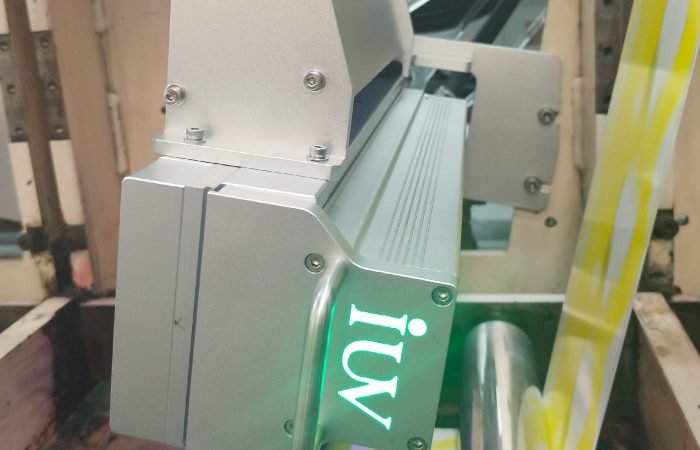Switching to an LED curing system offers significant environmental advantages for the printing industry. This advanced technology provides a cleaner, more efficient way to dry inks and coatings. It’s particularly beneficial for label printing, flexographic printing, offset printing, and narrow web printing operations. Understanding UV curing principles is key to appreciating these benefits.
Traditional curing methods often rely on mercury-vapor lamps. These lamps consume a lot of energy. They also generate considerable heat. This heat can lead to increased energy bills and a larger carbon footprint. Mercury is also a hazardous material. Its disposal requires special handling and can pose environmental risks.
LED curing systems, on the other hand, use light-emitting diodes. These diodes are highly energy-efficient. They use significantly less power than conventional lamps. This translates directly into lower electricity consumption for your printing press. Reduced energy use means a smaller environmental impact. Businesses can see substantial savings on their utility costs.
Furthermore, LED systems produce very little heat. This is a major advantage. Lower operating temperatures mean less strain on the printing equipment. It also reduces the need for extensive ventilation systems that would otherwise be required to dissipate heat. This can further lower energy demand. For narrow web printing, where space can be at a premium, this reduction in heat output is especially valuable.
The lifespan of LED lamps is another critical environmental factor. LED lamps last much longer than mercury-vapor lamps. They can operate for tens of thousands of hours. Mercury lamps need frequent replacement. This frequent replacement not only adds to operational costs but also generates more waste. Fewer replacements mean less material waste. This contributes to a more sustainable production process.
The absence of mercury in LED systems is a huge environmental win. Mercury is a toxic heavy metal. Its release into the environment can contaminate soil and water. It poses risks to wildlife and human health. By eliminating mercury from the curing process, LED systems remove a significant environmental hazard. This makes printing operations safer for workers and the surrounding ecosystem.
In label printing, where vibrant colors and sharp details are paramount, LED UV curing excels. It allows for instant drying of inks. This prevents smudging and ensures high print quality. The speed of LED curing also means faster production cycles. Faster cycles, combined with lower energy use, enhance overall operational efficiency. This efficiency directly contributes to a more environmentally responsible printing business.
Flexographic printing, widely used for packaging and labels, benefits immensely from LED technology. Flexo printing often involves large volumes. The energy savings from LED curing can be substantial at scale. The precise control offered by LED systems also allows for finer ink laydown. This can reduce ink waste. Less ink waste means less chemical waste and a more sustainable use of resources.
For offset printing, particularly in narrow web applications, LED curing is a game-changer. Traditional offset printing often uses heat-set inks that require significant energy for drying. UV-cured inks, when used with LED systems, dry instantly. This eliminates the need for bulky, energy-intensive drying towers. This frees up valuable space on the printing press. It also dramatically cuts down on energy consumption.
The environmental benefits extend beyond energy and material savings. LED curing systems often run cooler. This can lead to a safer working environment. Reduced heat means less risk of thermal degradation of the printed materials themselves. It also contributes to a more comfortable workplace for operators.
The instant curing nature of LED UV technology also opens doors for new printing applications. It allows for printing on heat-sensitive substrates. This expands the range of materials that can be used. Using a wider variety of substrates, including recycled or biodegradable options, further enhances the environmental profile of printed products.
When considering a switch, it’s important to look at the full lifecycle of the technology. While the initial investment in LED curing equipment might seem higher, the long-term savings are considerable. These savings are not just financial; they are also environmental. Lower energy bills, reduced waste, and the elimination of hazardous materials all contribute to a healthier planet.
The precision and control offered by LED systems also play a role. They allow printers to use inks and coatings more efficiently. This can lead to less overspray and reduced waste of these materials. This level of control is crucial for complex jobs, like those often found in narrow web and label printing.
In summary, adopting LED curing technology is a forward-thinking decision for any printing business. It addresses key environmental concerns head-on. It offers a path to greater sustainability. From flexographic and offset printing to specialized label production, the advantages are clear. Reduced energy consumption, lower heat output, extended lamp life, and the elimination of hazardous materials all contribute to a cleaner, greener printing process. Embracing this technology is not just good for business; it’s good for the environment.












